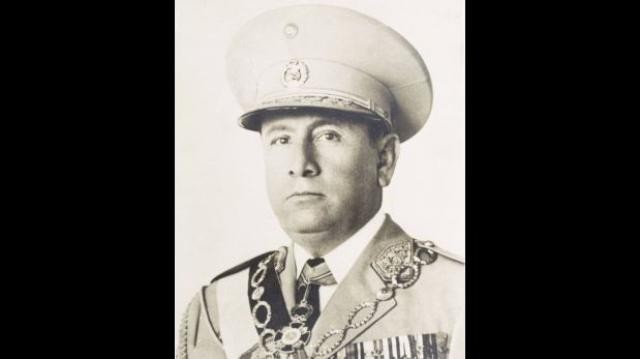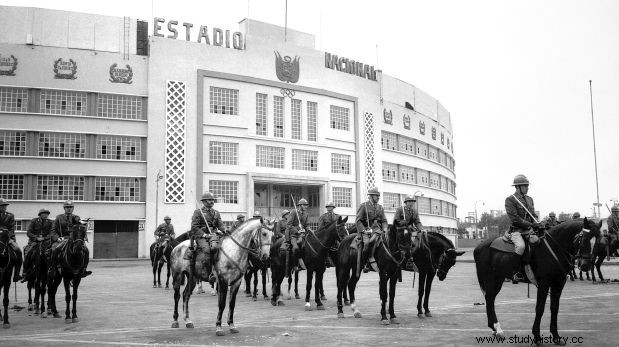
—The military career— In 1914 Odría moved to Lima with his family. He entered the Military School of Chorrillos, where he graduated as sword of honor of his promotion in 1919. His outstanding military career earned him admission to San Marcos, where he studied Mathematics, and to the Naval General Staff, which awarded him a diploma. He continued climbing positions until his moment of glory arrived, in 1941, when he participated in the Battle of Zarumilla, a key victory in the war with Ecuador. He obtained the rank of colonel and went on to direct the Escuela Superior de Guerra del Perú. It was thus that he traveled to the United States to train on the latest in the war industry until, in 1946, he was promoted to brigadier general. Later, José Luis Bustamante y Rivero thought it convenient to give him the Ministry of Government and Police. No one imagined that he would become the coup leader of the government that took him in.
—A classic dictatorship — From 1948 to 1956, during the Eighth Year, Peru experienced, in its own way, the vicissitudes of those Cold War dictatorships supported by Washington, as long as they guaranteed a dam to the advance of "international communism", regardless of their corruption or violations of the institutional order. Those were the years of Leonidas Trujillo in the Dominican Republic, Fulgencio Batista in Cuba, Gustavo Rojas Pinilla in Colombia or Marcos Pérez Jiménez in Venezuela. The antagonistic interests of the exporting oligarchy and APRA conspired to liquidate the democratic efforts of the Bustamante and Rivero government. . But the final victory belonged to the first, who encouraged Odría to lead the conservative coup of October 27, 1948, which began in the Arequipa garrison. Peru was returning to 'normality', commented the poet Martín Adán. Odría headed a Government Junta that was to call elections in 1950. But the elections of that year, perhaps the most fraudulent of the Peruvian 20th century, converted the caudillo of this “ restorative revolution” in sole candidate. Thus, the lucky winner would govern for six more years with a decorative Congress, full of courtiers. Through the Internal Security Law, which suppressed or limited individual liberties, leftist parties were outlawed; In addition, it provided ample room to intimidate, imprison, or exile opposition politicians and journalists. The most symbolic case of this 'steamroller' was Haya de la Torre's asylum in the Colombian Embassy. The dirty work was entrusted to an obscure character, Alejandro Esparza Zañartu, who, from the Ministry of Government, organized a complex network of snitches whose main objective was not only to persecute Apristas and Communists, but also to suffocate any form of worker and student protest in the streets.
—The exceptional export situation— Unlike his predecessor, Bustamante and Rivero, who was left with a world economy in ruins due to the end of the war in 1945, Odría's stars aligned. Thanks to the reconstruction of Europe and the Korean War, the prices of raw materials skyrocketed. It was only necessary to amend the economic policy, largely dictated by Pedro Beltrán, president of the BCR, which consisted of leaving private initiative free and eliminating controls. Thus, exports doubled, there was an annual growth of 6.5% and income per inhabitant expanded 36%. This gave the image of a 'successful' dictatorship that carried out an ambitious program of public works that had not been seen since the time of Leguía. Under the motto “Health, education and work” The National Stadium, the Employee Hospital and the Ministries of Education, Finance and Labor arrived. Those cement moles symbolized the boom times. Health policies were entrusted to the Cooperative Public Health Service, which focused on the jungle to combat epidemic diseases and build a hospital in Iquitos. Regarding education, a program was established to modernize the content of courses, raise teachers' salaries and build schools. This is how the Great School Units were born, whose architecture evoked a controversial modernism (because they looked more like military barracks), from which thousands of young people aspired to university education. The workers were favored with the Sunday salary and the employees with the creation of the Compulsory Social Security.
The social housing policy planned in the previous regime was continued. The National Housing Corporation (CNV) built three more “neighborhood units” in Lima:Matute (1952), El Rímac (1954) and Mirones (1955). Other housing complexes (called “groupings”) were aimed at public employees such as Angamos, Miraflores, Alexander, San Eugenio, Hipólito Unanue and Barboncito. The CNV also devised a series of temporary housing premises with recreation services for workers; Thus, the Huampaní Vacation Center was born (1955). In the provinces, 1,782 homes were ordered to be built in Cusco, Ica, La Oroya, Tacna and Piura. In Callao, two groups were built, with just over 400 homes, and the large Santa Marina unit, with 1,010 apartments.
 The National Stadium, inaugurated in 1952, was one of the emblematic works of the government of Odria. Houses and schools were also built. (El Comercio Historical Archive) —Corruption and populist clientelism— The consolidation of the system of "commissions" to allocate public works contracts and other State businesses, according to Bustamante and Rivero, was the key to corruption during the Ochenio. While the export sector was cashing in, a group of soldiers and businessmen, close to the dictator, did big business, without any type of control, as in any dictatorship. Defense spending, for example, grew ostensibly and generated juicy bonuses. The perception of illicit enrichment by Odría and his friends was notorious. The president was known to like gifts, from real estate to jewelry. The whole country found out, for example, that the Odría estate, in Monterrico, was the residence that his “friends” gave him in gratitude for his favors. Added to this feast was an aggressive social assistance plan aimed at winning the support of the migrant population in Lima and other cities. A relevant role in buying, with public money, popular favor fell to the dictator's wife, María Delgado, who attended to the needs of women and children in an open populist style. In a Creole version of Eva Perón, the first lady sought unconditional adherence to the figure of Odría, distributing basic necessities in the new neighborhoods. Her husband, meanwhile, allowed and "legalized" the invasion of land. Alfonso Quiroz calculates that up to 47% of the treasury was wasted in this waste of works and gifts, 3.7% of the GDP at that time.
The National Stadium, inaugurated in 1952, was one of the emblematic works of the government of Odria. Houses and schools were also built. (El Comercio Historical Archive) —Corruption and populist clientelism— The consolidation of the system of "commissions" to allocate public works contracts and other State businesses, according to Bustamante and Rivero, was the key to corruption during the Ochenio. While the export sector was cashing in, a group of soldiers and businessmen, close to the dictator, did big business, without any type of control, as in any dictatorship. Defense spending, for example, grew ostensibly and generated juicy bonuses. The perception of illicit enrichment by Odría and his friends was notorious. The president was known to like gifts, from real estate to jewelry. The whole country found out, for example, that the Odría estate, in Monterrico, was the residence that his “friends” gave him in gratitude for his favors. Added to this feast was an aggressive social assistance plan aimed at winning the support of the migrant population in Lima and other cities. A relevant role in buying, with public money, popular favor fell to the dictator's wife, María Delgado, who attended to the needs of women and children in an open populist style. In a Creole version of Eva Perón, the first lady sought unconditional adherence to the figure of Odría, distributing basic necessities in the new neighborhoods. Her husband, meanwhile, allowed and "legalized" the invasion of land. Alfonso Quiroz calculates that up to 47% of the treasury was wasted in this waste of works and gifts, 3.7% of the GDP at that time.—The legacy of Odriism— Political pressure and fiscal disorder forced Odría to leave power in 1956, but not before wanting to go down in history as the politician who gave women the vote. And fortune continued to accompany him. He got the next government, that of Manuel Prado, to decide not to investigate his dictatorship for the sake of political 'coexistence' and 'peace'. This allowed him to maintain his popularity, found a political party (Unión Nacional Odriísta), run twice for the presidency, try to get his wife elected mayor of Lima in 1963, and be an active participant in Peruvian politics. Leguía or Velasco, Odría enjoyed more years of life to manage his political legacy. With the support of the oligarchy, which lived its second and last moment of happiness since the years of the Aristocratic Republic, Odriism founded the first right-wing populist dictatorship in contemporary Peru. From 1956 to 1968, he was key in preventing, thanks to his alliances with the Pradismo and the Aprismo, the reforms that, in democracy, should have disrupted the oligarchic order, and that explain the subsequent coup by Velasco. be an honor for Odría —who died quietly at home in 1974 — That a novel by our Nobel Prize winner, "Conversation in the Cathedral", masterfully portrays the entrails of his tyranny.
Juan Luis Orrego Historian
http://elcomercio.pe/movil/eldominical/articulos-historicos/manuel-arturo-odria-dictador-afortunado-noticia-1947937
